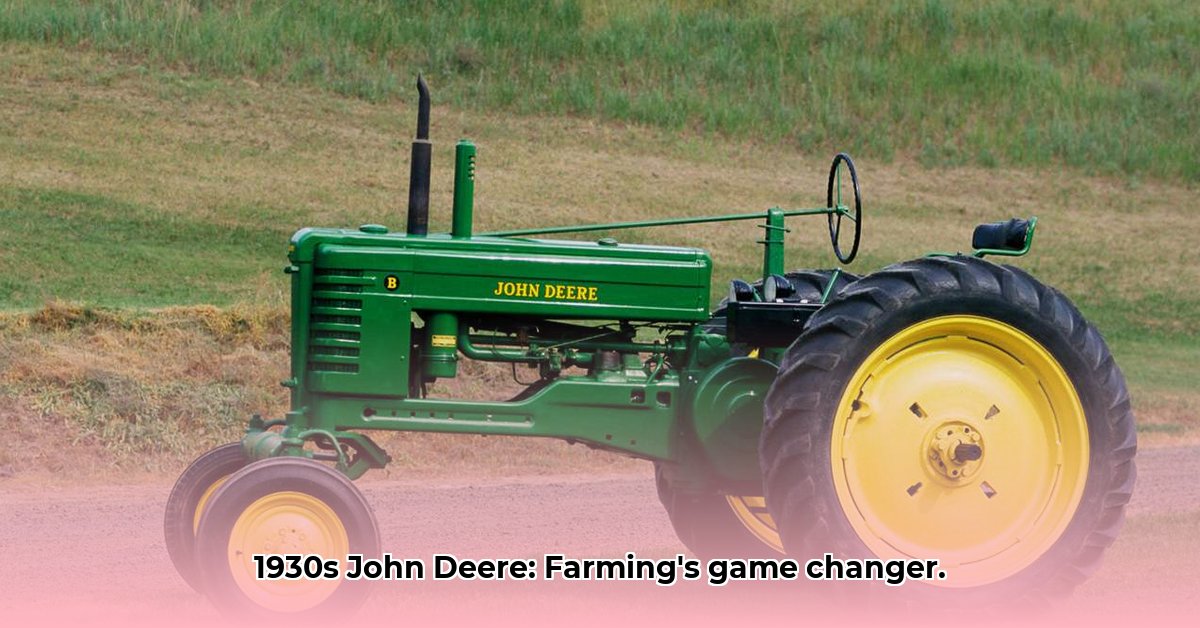
A Legacy Forged in Dust and Dreams
The year is 1930. Dust Bowl winds whip across the parched American plains, a stark backdrop to the Great Depression's relentless grip. Farmers, facing plummeting crop prices and crippling drought, cling to the vestiges of hope. Into this desperate landscape rolls a machine that would rewrite the future of agriculture: the 1930 John Deere tractor. More than just a machine, it represented a lifeline – a symbol of resilience and technological progress in the face of unimaginable hardship. This article explores its revolutionary impact, its enduring legacy, and the evolution of John Deere's commitment to sustainable agriculture. For tractor part replacements, check out this helpful resource.
Farming in the Shadow of the Depression
The 1930s presented an unparalleled challenge for American farmers. Imagine: fields choked by dust, prices plummeting, and banks seizing farms at an alarming rate. Horses, the backbone of agricultural labor for generations, proved inadequate for the demands of large-scale farming. The sheer physical toll was immense, yet yields remained insufficient. Against this backdrop of despair, the 1930 John Deere tractor emerged as a beacon of innovation.
This wasn't just any tractor; it embodied significant advancements. A more potent engine enabled it to conquer harsher terrains and cultivate larger areas. Improved maneuverability reduced operator strain. These seemingly modest enhancements represented a seismic shift in agricultural technology. The impact extended far beyond mere efficiency; it altered the very fabric of farming practices. But the transition wasn't without its hurdles. Farmers had to adapt, learn to operate and maintain this sophisticated machinery, requiring a significant shift in their established farming techniques.
The 1930 John Deere Tractor: A Technological Leap
Before widespread tractor adoption, farming was overwhelmingly labor-intensive. Planting, tilling, and harvesting relied heavily on manual labor or animal power—a backbreaking and time-consuming process. The 1930 John Deere tractor dramatically altered this equation. Farmers could now cultivate far larger areas with considerably less manual labor. The increase in output was profound. Larger areas could be planted and harvests became far more efficient, leading to potentially higher yields and income. Did this immediate increase in efficiency come without any downsides? We'll explore that in the next section.
John Deere: A Commitment Beyond Profit
John Deere's response to the Great Depression wasn't solely driven by profit. Recognizing the dire circumstances of their customers, they implemented flexible payment plans and extended credit, enabling farmers to acquire this life-saving machinery. This strategic decision solidified their reputation as not merely a manufacturer, but a vital supporter of the agricultural communities they served. This commitment, in an era focused on short-term gains, displayed an exceptional level of foresight and a dedication to long-term sustainability. This long-term view is something that continues to inform John Deere's business practices today, and is an integral part of their modern sustainability goals.
Sustainability: A Legacy of Innovation and Trade-offs
The 1930 John Deere tractor, while dramatically boosting agricultural productivity, also introduced unforeseen environmental considerations. The widespread adoption of mechanized farming, powered by fossil fuels, contributed to soil erosion and habitat loss. Increased efficiency, while enhancing yields, inadvertently led to farmland expansion, often at the expense of natural habitats. These trade-offs remain a subject of ongoing debate.
Recognizing this historical context, John Deere is now actively engaged in developing sustainable farming solutions. They are investing heavily in electric tractors, precision farming technologies that minimize waste, and alternative fuel sources. This proactive approach underscores their commitment to mitigating the environmental impact of mechanized agriculture. However, the transition to truly sustainable agriculture is a complex and protracted process.
John Deere's Modern Sustainability Initiatives: A Comparative Perspective
John Deere's commitment to sustainability is not a recent trend; it's deeply rooted in their historical support for farmers during challenging times. While they've made substantial progress in precision agriculture and emission reductions, a comprehensive assessment requires a comparative analysis with competitors like AGCO, CLAAS, CNH Industrial, Kubota, and Toro. A detailed comparison would illuminate John Deere’s strengths and weaknesses relative to industry benchmarks. The success of their sustainable technologies also hinges on farmer adoption, which is affected by cost, ease of use, and technological literacy.
A Continuing Legacy: Then, Now, and the Future
The narrative of the 1930 John Deere tractor is far more than a historical footnote. It's a compelling story of technological transformation, the intricate relationship between innovation and environmental responsibility, and the persistent need to balance progress with sustainability. From the depths of the Great Depression to the current pursuit of environmentally sound farming practices, the story unfolds. Ongoing research and advancements in sustainable agriculture promise a future where the world can be fed without compromising the planet's health—a journey that continues to evolve.